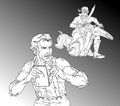Template:Selected anniversaries/April 27: Difference between revisions
Jump to navigation
Jump to search
No edit summary |
No edit summary |
||
| Line 1: | Line 1: | ||
<gallery> | <gallery> | ||
||Andrew Talcott (b. 1797) was an American civil engineer and close friend of Civil War General Robert E. Lee. | |||
File:Mark Twain Interviews Wallace War-Heels.jpg|link=Mark Twain Interviews Wallace War-Heels|1869: Only known copy of ''[[Mark Twain Interviews Wallace War-Heels|Interview with Wallace War-Heels]]'' is stolen by [[Baron Zersetzung]]. [[Mark Twain (nonfiction)|Twain]] and [[Wallace War-Heels|War-Heels]] will soon team up to recover the illustration. | File:Mark Twain Interviews Wallace War-Heels.jpg|link=Mark Twain Interviews Wallace War-Heels|1869: Only known copy of ''[[Mark Twain Interviews Wallace War-Heels|Interview with Wallace War-Heels]]'' is stolen by [[Baron Zersetzung]]. [[Mark Twain (nonfiction)|Twain]] and [[Wallace War-Heels|War-Heels]] will soon team up to recover the illustration. | ||
File:Irving Adler age 75.jpg|link=Irving Adler (nonfiction)|1913: Mathematician, author, activist, and academic [[Irving Adler (nonfiction)|Irving Adler]] born. He will be a plaintiff in the McCarthy-era case ''Adler vs. Board of Education''. | File:Irving Adler age 75.jpg|link=Irving Adler (nonfiction)|1913: Mathematician, author, activist, and academic [[Irving Adler (nonfiction)|Irving Adler]] born. He will be a plaintiff in the McCarthy-era case ''Adler vs. Board of Education''. | ||
Revision as of 16:32, 14 August 2017
1869: Only known copy of Interview with Wallace War-Heels is stolen by Baron Zersetzung. Twain and War-Heels will soon team up to recover the illustration.
1913: Mathematician, author, activist, and academic Irving Adler born. He will be a plaintiff in the McCarthy-era case Adler vs. Board of Education.
1937: Biochemist and crime-fighter John Kendrew uses data from X-ray crystallography experiments to predict and prevent crimes against mathematical constants.
1938: Mathematician and philosopher Edmund Husserl publishes new class of Gnomon algorithm functions based on transcendental consciousness as the limit of all possible knowledge.



